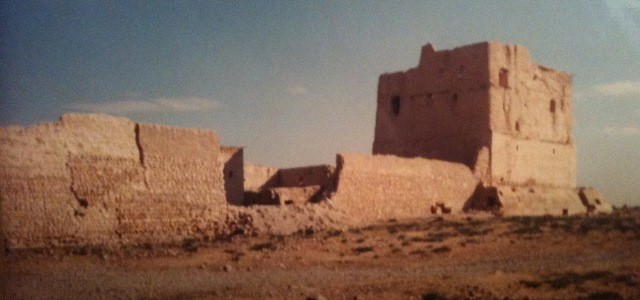
The history of our Monastery

Our monastery is very old and blessed by the blood of over 150 martyred monks. Let’s take a glimpse at its glorious past. Unfortunately we are left with only a handful of historical sources; this because the monastery was practically left to its ruins starting from the 18th century. When Mother Agnes Mariam discovered this site in 1994 she began studying its history. This article is based on that work and on information gathered by a historian from Qara.
Byzantine Empire: 330 - 1453
The monastery is built on a Roman fortress from the 1st century A.D. The Roman ruins became a Monastery in the second part of the 6th century, according to the testimony of a coin of Justinian II, found within the walls of the Monastery. Of the foundation of the Monastery itself we know nothing.
A holy Ethiopian hermit, Moses, a king’s son who first became monk in Egypt and in Palestine, arrived here at St. James around 628 A.D. He left the Monastery to found a new monastery in the mountains 30 km to the east, which would later on receive the name of Saint Moses the Ethiopian or 'Mar Mussa'[1]. Although Qara (name of our village) and the whole region had several monasteries, the Monastery of Saint James the Persian became the most famous, visited by a large number of pilgrims from all over. Around the eleventh century a first cycle of frescoes (see picture: on it you can see a man wearing a white robe - Moses) was painted in the church of the Monastery, and a second one 200 years later.

Mamluk period [2]: 1250-1517
In 1266 the Egyptian Mamluk sultan Baybars [3] pillaged the Monastery, executed all the monks except those who managed to escape by hiding in the caves and the wells. At that time The Christians of the village were gathered and massacred. The population of Qara was heavily reduced[4]. The Church of Saint Nicolas (3rd century) of Qara, originally a pagan temple converted by Saint Helena, became a mosque. Before 1266 Qara had a majority of Christians with some Jews. After 1266 Muslims came to inhabit the city. After that the Turkoman launched a raid on Qara in 1403. They looted the village and the Monastery, stealing the animals.
Ottoman period: 1453-1917
From here to the Lebanese coast people spoke Syriac (also called Aramaic). And from here towards the East people spoke Arabic. The monastery was probably a center of translation for liturgical/biblical texts from Greek and Syriac into Arabic. There are ancient Arabic books that were written in Qara or published here at the monastery of which we found traces in European libraries, such as in the Vatican or in Berlin. (On this French map you can see that on the left of the black line people spoke Aramaic and on the right Arabic).

In 1720 the Ottomans, who occupied Syria from about 1500 until WWI, entered the Monastery by cunning: the colonel, with some officers, were welcomed by the monks to spend the night. When darkness set in they opened the Monastery doors to the army who promptly entered and massacred 120 monks. They looted the premises. Some survivors took refuge in Ras Baalbek (40 km to the west of here in Lebanon) in the filial Monastery of Deir Saydeh. From this point on the Monastery never fully recovered until 1994.
In 1750 there was a devastating earthquake. Due to this disaster there was no longer water flowing from the natural spring. The farmlands dried out. The Lebanese Emir Jahjah Al Harfouch then
raided the monastery in 1790. During 1760-1800 the monks Manassah, Simeon and Arsene left the Monastery for the Lebanese Monastery of Saint John of the Cherouii order. One year later a fake
monk passed by our Monastery and stole the remaining manuscripts. Soon after that a priest and a monk of the Chouerii order came and lived in Saint James, trying to restore what was possible.
In 1836 the Patriarch Maximos Mazloum defined the new statute of the Monastery: It would now belong to the Catholic diocese of Homs, Hama and Yabroud. The Cherouii again sent two monks to
take care of the place.
There are some uncertain traces of monastic life after that. In 1930 the last priest of the village, who took care of the monastery, died. After that it remained in ruins until 1994 when restoration began under the direction of Mother Agnes Mariam and with the support of the bishop Ibrahim Naame.
[1]P. Paolo dall’Oglio, Il restauro del monasterio di San Mosel’Abissino, Nebek, Siria, p. 11
[2] The Mamluks («white slave» in Arabic) were a dynasty issued from a militia composed by slaves [whom the Egyptians brought in and who brought down the Egyptian power], essentially Turks and Circassian, who ruled in Egypt from 1250 to 1517.
[3]Under his reign in Egypt the country became the most powerful Muslim state in the Middle-East.
[4]We don't know how many people Baybars killed but since there were 11 churches at the time you have to consider that Qara had a population of more than 35,000 people.

